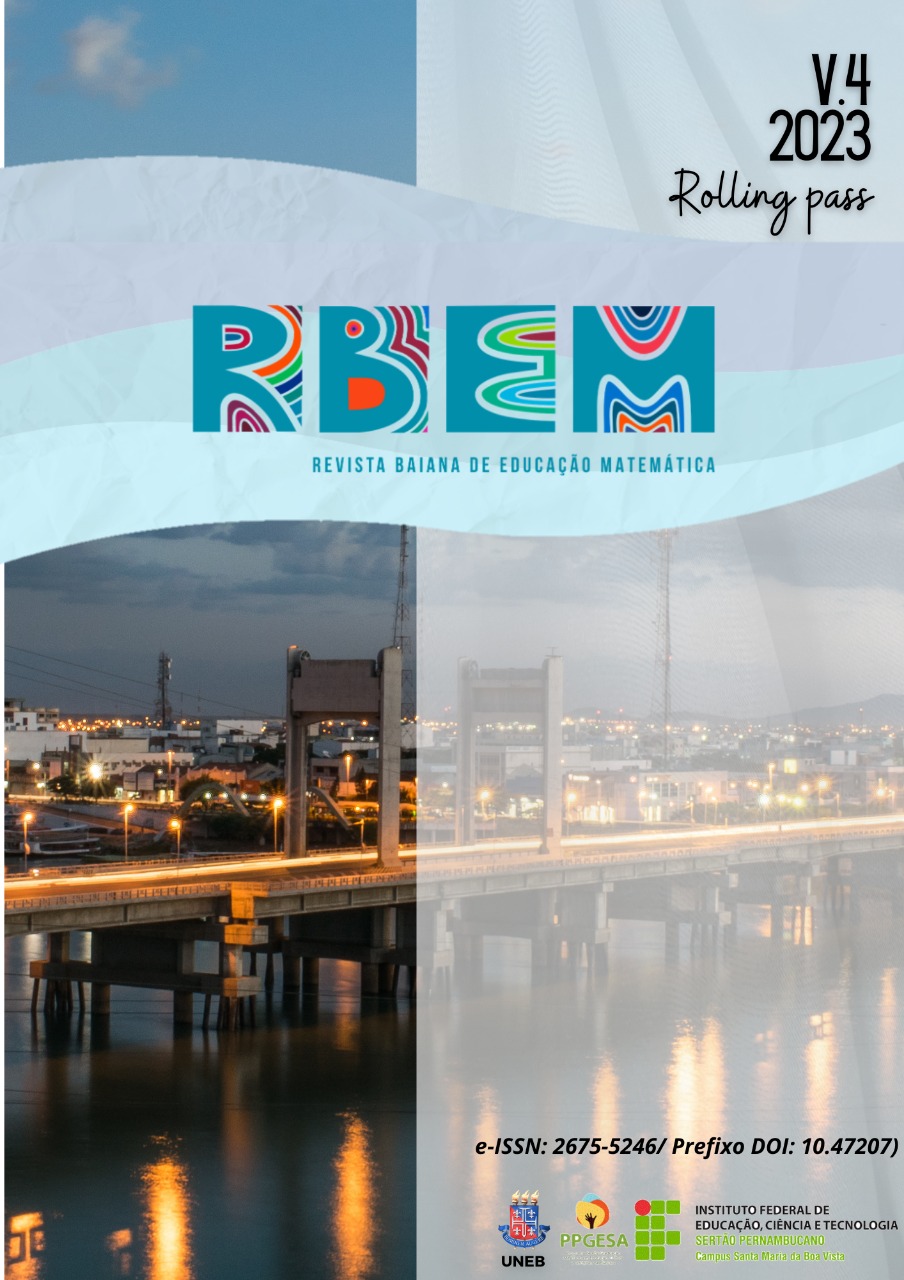Analysis of the mathematics textbook: a study of the TDICs used and the selective attention in the learning of the sine function.
DOI:
https://doi.org/10.47207/rbem.v4i01.15779Keywords:
Textbook. Sine function. Selective Attention. Technology.Abstract
This study aimed to analyze which technological tools for teaching the sine function and its relationship with selective attention are present in the textbook. With advances in technology and changes in society, mathematics teaching tends to change. It is currently perceived that concepts of cognitive neuroscience are more present in education, bringing different contributions to teaching and learning. This article presents the results of an analysis carried out in a textbook of the PNLD (2021) from the Ser Protagonista collection, from the new high school, in the area of mathematical knowledge and its technologies. This is a qualitative research and emerged from the analysis of the units and chapters of the book, highlighting selective attention as an important factor for learning from technologies. The results of the analysis show that attention is an inherent factor in the development of learning and that technology contributes positively.
Downloads
References
ALMEIDA, Maria Elizabeth Bianconcini de. Informática e Formação de professores. Brasília: Ministério da Educação, 2000.
BRASIL, Ministério da Educação. Base Nacional Comum Curricular. Brasília, DF: Ministério da Educação, 2018.
CASTELLS, Manuel. A questão urbana. 3 ed. São Paulo: Paz e Terra, 2006.
COLL, César.; MONEREO, Charles. Psicologia da educação virtual: aprender e ensinas com as tecnologias da informação e da comunicação. Porto Alegre: Artmed, 2010.
COSENZA, Ramon Moreira; GUERRA, Leonor Bezerra. Neurociência e educação - Como o cérebro aprende. Porto Alegre: Artmed, 2011.
FONSECA, Laertes Silva. Um estudo sobre o Ensino de Funções Trigonométricas no Ensino Médio e no Ensino Superior no Brasil e França. 2015, 1v. 495p. Tese de Doutorado. Universidade Anhanguera de São Paulo, São Paulo (SP).
GAZZANIGA, Michael; IVRY, Richard; MANGUN,George. (2006). Neurociência Cognitiva: a biologia da mente. Porto Alegre: Artmed.
HOWLAND, Jane; JONASSEN, David; MARRA, Rose. (2011). Meaningful Learning with Technology. 4. ed. Boston: Pearson. 292 p.
LÉVY, Pierre. Cibercultura, Rio de Janeiro: Editora 34, 1999.
LIMA, Ricardo Franco de. Compreendendo os mecanismos atencionais. Ciência e Cognição, 6, 113- 122, 2005.
LÜDKE, Menga.; ANDRÉ, Marli. E. D. A. Pesquisa em educação: abordagens qualitativas. São Paulo: EPU, 1986.
MOREIRA, Kênia Hilda. Um mapeamento das pesquisas sobre o livro didático de história na região Sudeste: 1980 a 2000. 171 f. Dissertação (Mestrado em Educação) – Faculdade de Ciências e Letras. UNESP‐Araraquara. São Paulo, 2006.
MYERS, David. Psicologia. 9ª ed. São Paulo: LTC, 2012.
OLIVEIRA, Maria, Marly de. (2010). Como fazer pesquisa qualitativa. Vozes.
POZO, Juan Ignacio. Aprendizes e mestres: a nova cultura da aprendizagem. Trad. Ernani Rosa. Porto Alegre: Artmed, 2008.
PRENSKY, Marc. Digital Natives Digital Immigrants. In: PRENSKY, Marc. On the Horizon. NCB University Press, Vol. 9 No. 5, October (2001a). Disponível em: <https://www.marcprensky.com/writing/Prensky%20%20Digital%20Natives,%20Digital%20Immigrants%20-%20Part1.pdf>. Acesso 27 abril 2022.
RIVERO,Thiago, Santos et al. Videogame: Seu impacto na atenção, percepção e função executivas. Revista Neuropsicologia Latinoamericana, v.1 n. 1, p. 38-52, 2012.
STERNBERG, Robert James. Psicologia Cognitiva. Porto Alegre: Artmed, 2008.
STONE, Linda. Beyond Simple Multi-Tasking: continuous Partial Attention. Linda Stone, 2009. Disponível em: https://lindastone.net/2009/11/30/beyond-simple-multi-tasking-continuous-partial-attention/. Acesso em: 19 dez. 2022.
TORNAGHI, Alberto José da Costa.Tecnologias na Educação: ensinando e aprendendo com as TIC. 2. ed. – Brasília: Secretaria de Educação a Distância, 2010.
TOZONI-REIS, Marilia Freitas de Campo. Metodologia da pesquisa. 2.ed. Curitiba: IESDE Brasil S.A., 2009. 136 p.
Downloads
Published
How to Cite
Issue
Section
License
Uma nova publicação de artigo anteriormente publicado na Revista Baiana de Educação Matemática, fica sujeita à expressa menção da precedência de sua publicação neste periódico, seguindo as normas de referência. Autores que publicam na RBEM concordam com os seguintes termos:
-
O Conselho Editorial se reserva ao direito de efetuar, nos originais, alterações de ordem normativa, sintática, ortográfica e bibliográfica com vistas a manter o padrão culto da língua, respeitando, porém, o estilo dos autores. As provas finais poderão ou não ser enviadas aos autores.
-
Autores mantém os direitos autorais e concedem à revista o direito de primeira publicação, com o trabalho simultaneamente licenciado sob a Licença Creative Commons Attribution (CC BY-NC-SA).
-
Autores têm autorização para assumir contratos adicionais separadamente, para distribuição não-exclusiva da versão do trabalho publicada nesta revista, exemplo: publicar em repositório institucional ou como capítulo de livro, com reconhecimento de autoria e publicação inicial na RBEM.
-
Autores têm permissão e são estimulados a publicar e distribuir seu trabalho online — em repositórios institucionais, página pessoal, rede social ou demais sites de divulgação científica.


